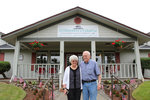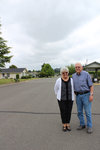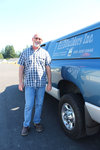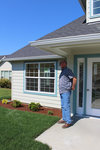




Editor’s Note: This is Part 1 in a two-part series on Stillwaters Estates. Look for Part 2 in Thursday’s edition.
Thirty years ago, Curtis Dean was working in commercial fishing when his father, Larry, called to ask him to return to the family business to help with a very large project.
This month, that job finally wrapped as LTJ Builders completed the final home in Centralia’s Stillwaters Estates. Other than a handful of homes, the construction company has built all of the more than 200 buildings in the community. For Dean, now the owner of LTJ Builders, the milestone is bittersweet as he has made the decision to retire from his family’s business of 50 years with its completion.
“The legacy is right here,” Dean said, pointing out the window to the homes of Stillwaters. “We’ve had thousands of customers over the years and to my knowledge they’re happy customers.”
It’s hard to picture today, but three decades ago, Stillwaters founders Dave and Diana Williams weren’t even sure the over-50 community could be built, let alone succeed.
In 1986, the area today known as Stillwaters Estates was farmland. The Williams family had built a home on property directly across Cooks Hill Road and David Williams said about 10 to 12 doctors and lawyers from the Twin Cities area lived on the hill above the 103 acres that at the time was part of unincorporated Lewis County. When neighbors got word the property owners were thinking about selling the property to be developed as a trailer park, several contributed $50 each to form a corporation to fight the development and attorney Ralph Olson represented them. Dave Williams explained their quarrel was not with lower income housing, but their concerns that as an unincorporated area, that development might proceed with little oversight or concern for the needs of current neighbors.
Dave Williams said it was Diana Williams who first suggested they purchase the land themselves. And they had an idea of what they might do with it. Dave Williams said the inspiration came from his patients, who, as they aged, often asked him “what’s going to happen to me?”
“Age is a cure-less disease,” Dave Williams said. “You can modify it but you can’t cure it.”
At the time, retirement communities were only available to the wealthy. The Williams family felt that people of varying income should also be able to afford a place where they could age safely. Diana Williams came up with designs for homes that included amenities like yard and home maintenance as part of the package; an absence of stairs of any kind; wide hallways and doorways that can accommodate a wheelchair if needed; and small details such as lever door handles and rocker style light switches that are easier to use.
The problem was, they didn’t have the money to do it. They had a funding partner Clarence “Clank” Robbins but a bank feasibility study suggested the idea was not sound.
“They said, ‘I think it’s a mistake for you to build in Lewis County because it’s not rich enough. You’d be better to go government-sponsored housing,’” Dave Williams recalled. “We also had to fight comments in the community saying ‘it’ll never work here.’”
“We were on a journey of faith and scared to death and knowing we don’t have the money to do this,” Diana Williams recalled.
A friend and fellow Christian, George Butkus, president of Rainer Bank, took a chance on them and offered their first loan of $300,000. It was enough to pour a foundation and bring a single modular home to the property. Eventually, they were able to expand to eight modular homes and two four-plex buildings. With their home and medical clinic on the line as collateral for their loans, they were grateful for those first residents.
“Most of these folks were local people who were brave enough to take a chance on us,” David Williams said. “Now, we have people who come here from all over the United States.”
“We didn’t know what we were doing, but we were willing to do it,” Diana Williams added.
It quickly became apparent that modular homes were not going to work at Stillwaters. For one, the high clay content of the soil meant bringing homes in all year round was not possible. And the foundation required for modulars made avoiding stairs difficult as well. They decided to hire a construction company to begin building houses on each site to order. LTJ Builders was recommended by Robbins and they built the majority of Stillwaters’ 227 individual buildings that include 206 homes, 89 rental homes, and the 79-unit Colonial Residence. Dean praised Dave and Diana Williams for their vision and said working with them was as close to old fashioned business ethics as you can get.
“We’ve literally built everything out here on a handshake,” Dean said.
Dean had worked in construction with his father, Larry, since childhood. He said at the time when his dad asked him to return to the family business, he didn’t realize how significant the Stillwaters project would become to him. Dean said he always loved visiting with older folks and enjoyed building relationships with Stillwaters residents as much as he enjoyed the actual building process.
“It’s not very often a builder gets to spend 30 years in the same place and gets to actually see what works and what doesn’t work. So, we’ve been able to change some things over the years to make them work better,” Dean said. “Being at Stillwaters, they have 100% access to us all the time. They’ll say ‘Curt, I’ve got a squeaky door’ and you go over and end up having coffee and cookies.”
LTJ Builders projects can be found throughout Lewis County, but Stillwaters is arguably the company’s largest project. Dean said when he started with the community, it comprised about 75% of the company’s work. More recently, as he had made the decision to retire, he had focused solely on the single project. One aspect of the project that some may never notice — but Dean said he is particularly proud of — is the community’s straight and true layout, even though the topography of the land is challenging. It was accomplished by laying out homes street by street, even if some of the homes on that street may take years to build, to ensure an even layout of neighborhoods since if they are well-maintained, the homes should last 100 years or more.
“It’s not glamorous work but we get to see what we accomplished at the end of our career,” Dean said. “You drive in here and you go ‘wow, it’s just beautiful.’ I started here when I was 28 to 29 years old and I’m 58 now getting to see this finished.”